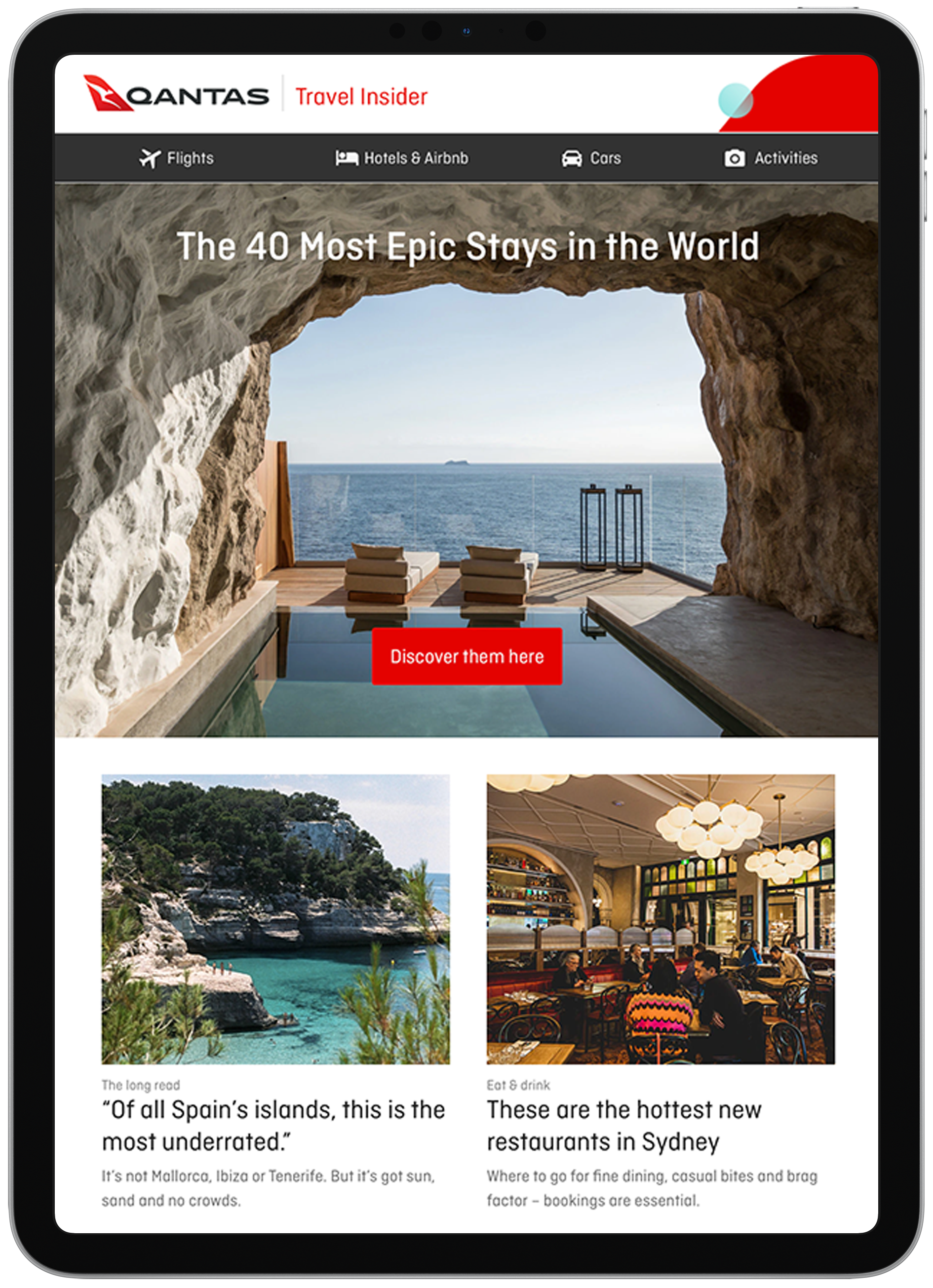5 Ways Businesses Are Using AI to Put People First

Is AI the end of humanity or the start of a promising new era of business efficiency with humans at the core? These companies fall squarely on the side of the latter.
Making AI your 24/7 instant assistant

Professional services firm EY takes AI so seriously that its “power-users” – the top 12 per cent of AI fans in its workforce – share tips on prompts for generative AI to help encourage their colleagues to experiment with the technology. “We hashtag it #PassthePrompt on our internal social media,” says Katherine Boiciuc, EY Oceania’s chief technology and innovation officer. “We want to make it culturally cool to share and create prompts.”
AI is not optional at EY – training to use the AI companion Microsoft Copilot is mandatory and EY’s career-development program offers further AI education all the way up to a masters via the EY Tech MBA by Hult. “Applied AI is the number-one skill set that clients and employees are asking for, taking out-of-the-box AI technology and applying it to specific-use cases to create value.”
EY closely tracks how its staff are using AI at work. “It reduces time spent on administrative and manual tasks,” says Boiciuc. “Nearly one in two of our people now use AI at least once a day and 72 per cent say it has a positive impact on their day-to-day roles. We estimate each user has saved about 30 minutes a week since the introduction of AI, which we expect to increase as more people embed it into their workflow.”
Which brings us back to the art of the prompt, the input that is key to unlocking GenAI’s large language models (LLMs) that the world first understood when ChatGPT publicly launched at the end of 2022. Boiciuc has written “mega-prompts” in Microsoft Copilot – powered by LLMs – as well as the firm’s private EY.ai platform. A mega-prompt is the next level of an AI prompt, essentially a framework of instructions for the AI system to produce specific outcomes or information, which users can save to make repeatable. Boiciuc is definitely a power-user, starting her day by putting AI to work before she’s even in the office.
“The prompt achieves six things: I ask it to plan my day and give me a summary of the day ahead; to scan all the technology news and make it into a table that is easy to ingest; to prepare a summary of all the priority emails in my inbox; to make an assessment of the order of priority and draft preliminary responses; to review all the Teams messages I’ve been tagged in and create a table with a prioritised list and draft responses; and to pull any actions forward from the previous day that were not achieved into a to-do list for today.”
After Boiciuc launches her daily mega-prompt, the view of all the things she’s asked the AI assistant to do is delivered “about two minutes later”. At the close of the day, she clicks her end-of-play prompt. “I ask it to review my inbox and my Teams messages and make sure there’s nothing urgent that should be done before I log off. It’s like a quality check so I can relax and step away from devices for a period of time and be with my family.” Boiciuc has her AI assistant deliver the results by text, although some colleagues choose to receive their response via AI voice. “I’m not there yet – I like to read it!”
In February, EY and Microsoft launched the AI Skills Passport (AISP), available in multiple countries for free. “It’s designed for anyone over the age of 16 who’s looking to enter the workforce or to have a career pivot,” she says. “It’s 10 hours of self-guided online training and a great way for SMEs and not-for-profits, who might be struggling with the investment to participate in the AI economy, to upskill their workforce.”
Pairing problems with AI solutions
“AI is the future for Australia and everyone needs to be ready to work with AI software tools or AI hardware, such as robotics,” says Distinguished Professor Jie Lu, director of the Australian Artificial Intelligence Institute (AAII) at the University of Technology Sydney (UTS). “You need to know how to collaborate with this technology because AI tools will be your team members in a few years, including for SMEs.”
Lu says AAII is the largest and top-ranked AI hub in Australia, with 34 staff and more than 200 PhD students working on theoretical research and AI applications for industry. Businesses come to AAII to address various issues, such as what to do when their customer churn is ticking upwards. “They spend a lot of money on customer retention so we build AI models that generate early predictions over which customers are going to leave, in time for them to take action.”
AAII has worked on more than 100 industry projects, including building a real-time prediction model of carriage congestion for Sydney Trains and using machine learning and drones to help SharkSpotter patrol beaches. Lu’s team also collaborated with a startup to create machine-learning models that improve the accuracy of gene-disease association prediction to support healthcare.
They are examples of problem-solving applications that can benefit bottom lines, enhance customer satisfaction, improve medical outcomes, elevate safety and help protect the environment.
Offering a side-serve of AI at the drive-through

Australian quick-service food company Oliver’s has 15 restaurants stretching the east coast, from Maryborough in Queensland to Officer in Victoria, in prime positions for road trippers. Founded in 2003, its selling points include healthier fast food, a connection to farmers and organic coffee. Late last year the chain debuted a cutting-edge digital element to its wholesome line-up. Introducing Ollie, which the company claims is Australia’s first AI drive-through assistant.
Oliver’s offers detailed nutrition information for all its menu items and has customers for whom that may be a medical necessity. One of the attractions of a digital assistant is its ability to share information on ingredients, kilojoules and cooking methods with 100 per cent accuracy.
“Ollie is always going to be there to assist rather than replace our team members,” says Oliver’s CEO Natalie Sharpe. “It relieves the pressure on our teams – they can focus on preparing high-quality food and giving a really good customer experience at the collection point.”
Oliver’s partnered with British Conversational Voice AI developer Sodaclick and the whole project took about a year, with five months of intense hands-on development, says Sharpe. “Ollie was trained on the data behind the Oliver’s menu and integrated with Prepit,” says Sharpe, who has a degree in nutrition and dietetics and is also co-founder of Prepit, software that helps manage food production.
“A key requirement was that Ollie must have a friendly personality with an Australian accent so he doesn’t sound robotic,” says Sharpe, who adds that the company is also developing a female counterpart, Olivia. The other advantage of digital AI servers is that they never forget the scripted upsell: “Would you like to make that a meal deal? How about a muffin with that?”
Since September last year, Ollie has been hard at work – on probation – in the southbound Oliver’s on the Hume Highway at Pheasants Nest, NSW, about 100 kilometres south-west of Sydney. Customers have the choice to bypass Ollie for a human in a headset who is always on hand but have mostly embraced the new team member.
“Some customers have special dietary needs and they have a lot of detailed questions – it’s important that we get that information right,” says Sharpe. “We do a lot of intense staff training on that but we also have lots of casual workers doing a shift or two a week so it can be challenging for everyone to know every ingredient or allergen on the menu. Ollie is a single source of truth with accurate, real-time information.”
Want to know how much protein is in the beef burger or if there’s garlic in the Moroccan vegetable bowl? Ollie can tell you almost instantly. It’s a prime example of how AI can help your people deal with the tricky stuff and focus on becoming expert at the fun stuff.
Training GenAI on specialist data
Technical data is a precious and often proprietary commodity that can be difficult to navigate. That’s why Australian design, engineering and advisory firm Aurecon created its GenAI assistant, Recall, collecting more than 600,000 pages of its own PDF, XLS, DOC and PPT documents and making them searchable via natural-language questions.
“All of our company’s institutional knowledge sits behind Recall,” says Dave Mackenzie, Aurecon’s group director of digital and AI. Aurecon has expertise across infrastructure, energy, resources and water. “Before Recall, to find specific technical knowledge I would search our internal systems for a document, read the document, find the passage I was looking for and then go and do my task. With natural language this process has shifted to asking Recall a question and getting the answer in seconds. We’re engineers so we have a culture of verification – all the sources are cited and we can make sure it’s aligned.”
Mackenzie says it only took “a month or two to build the first version of Recall” in late 2023. It was officially launched to the whole company shortly after. “It’s very intuitive – people log in and start playing with it and get it pretty quickly. We have added training around understanding the output and how to verify it – we always want to keep a human in the loop.” A pre-Recall technical information search took Aurecon team members an average of 14 to 18 minutes; now they receive it in less than 30 seconds.
After 12 months, Mackenzie and his team found that more than 301,000 questions had been asked of Recall, with 26 per cent deeply technical questions, 25 per cent questions around efficiency and 23 per cent about skills development. “Recall is saving people quite a lot of time and transforming how they access knowledge and information. We measure the time impact very conservatively and we believe we’ve chalked up about 18,000 hours of saved time since rolling out the system.”

The potential is still unfolding. “Our people can log into Recall and build their own custom apps inside it,” says Mackenzie. “They can tailor data specifically to a problem or project.”
Last year, Aurecon partnered with American AI startup Nomic to add its platform Atlas, designed to facilitate explainable and accessible AI systems from rows of messy text or image data. “At first we had about 50 users and now we have 800 users across the business using Atlas to create very complex, data-rich maps with all their project information, which can be added to their custom Recall apps,” says Mackenzie. “We’ve seen a wide range of people rapidly maturing their understanding of these tools and adopting AI to augment how they work. That’s been super-exciting.”
Taking care of small business
“While larger-scale firms are incorporating and benefiting from AI, smaller businesses do not have the same access to expertise,” says Dr Brett Szmajda, acting director of the federal government’s National Artificial Intelligence Centre (NAIC). “AI can be a great help for small business – it can help boost productivity immediately with many common jobs,” he adds. “It can streamline tracking of expenses, draw hidden insights from client data or write creative and engaging marketing messages.”
NAIC tracks AI adoption and sentiment among Australian SMEs and its latest findings show that while 35 per cent are already adopting AI, 23 per cent are not aware of how to use it and a troubling 42 per cent are not planning to adopt it. The report found the highest uptake of AI – 45 per cent – is in the health and education and manufacturing sectors, and the lowest – six per cent – in agriculture, forestry and fishing.
“To help small businesses, the government has sponsored AI fundamentals courses and created four specialised AI Adopt Centres that can help with free one-on-one guidance.”



